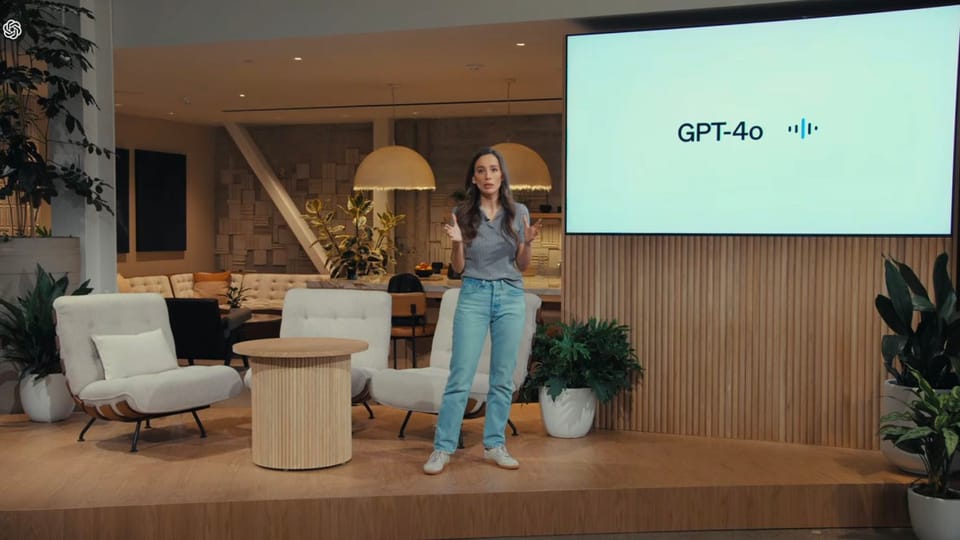OpenAI unveils GPT-4o: Bringing advanced AI capabilities to the masses

OpenAI announced GPT-4o, their latest foundational language model. Building upon the success of GPT-4, this new iteration promises to democratize access to cutting-edge AI technology by offering GPT-4 level intelligence to all users, including those on the free tier.
Mira Murati, OpenAI's Chief Technology Officer, announced its commitment to making its advanced AI tools widely accessible. "A significant part of our mission is to be able to make our advanced AI tools available to everyone for free," Murati stated during the presentation. This move is expected to significantly lower the barrier to entry for individuals and businesses looking to harness the power of AI.
One of the most notable aspects of GPT-4o is its improved ease of use. OpenAI has focused on reducing friction points and making the interaction with the model more natural and intuitive. Launching a desktop version of ChatGPT and a refreshed user interface aims to integrate the AI assistant seamlessly into users' workflows.
Under the hood, GPT-4o represents a leap forward regarding its text, vision, and audio capabilities. The model can now reason natively across these modalities, eliminating the need for separate transcription, intelligence, and text-to-speech models. This unified approach reduces latency and allows for a more immersive and fluid collaboration experience with ChatGPT.
The implications of GPT-4o's enhanced capabilities are far-reaching. With the ability to analyze screenshots, photos, and documents containing both text and images, ChatGPT can now engage in conversations about a wide range of content. This allows users to leverage AI in their daily tasks, from analyzing data to generating insights from visual information.
One of the most exciting demonstrations was GPT-4o's coding assistant capabilities. Mark Chen walked through a live demo in which GPT-4o understood and interacted with code displayed on a computer screen. Users could converse about the code's functionality and purpose by simply highlighting the code and sending it to the ChatGPT app.
When asked to provide a one-sentence description of the code, GPT-4o accurately summarized that it "fetches daily weather for a specific location and time period, smooths the data using a rolling average, annotates a significant weather event on the resulting plot, and displays the plot with the average, minimum, and maximum temperatures over the year."
This level of code comprehension and summarization could greatly assist developers in understanding complex codebases and collaborating more effectively. GPT-4o also provided insights into the role of specific functions within the code. When asked about the impact of removing a particular smoothing function, the model explained that the temperature plot would show more noise and fluctuations in the data without it.
This ability to reason about code changes and their effects could streamline developers' debugging and optimization process. The live demo culminated with GPT-4o analyzing the generated temperature plot, accurately identifying the hottest months and temperatures in Celsius and Fahrenheit. This seamless integration of vision, language, and domain-specific knowledge showcases the model's potential to revolutionize how developers interact with and understand their code.
Another significant development is the introduction of GPT-4o to OpenAI's API. Developers can now build applications powered by GPT-4o and deploy them at scale. With faster performance, lower costs, and higher rate limits compared to GPT-4 Turbo, this move is expected to accelerate the adoption of AI in various industries and spur innovation in the field.
During the live demonstration, Mark Chen and Barrett Zoph, two of OpenAI's research leads, showcased GPT-4o's real-time conversational speech capabilities. The model's ability to engage in natural, back-and-forth dialogue with emotional nuance and contextual understanding was impressive. This technology's potential applications span virtual assistants to educational tools and beyond.
GPT-4o's vision capabilities were also fully displayed during the live demo. Barrett Zoph demonstrated how users can interact with ChatGPT through real-time chat and sharing visual content. By booting up the ChatGPT app, users can converse and seek assistance with various tasks, including solving math problems.
In the demo, Zoph wrote down a linear equation on a sheet of paper and asked ChatGPT for help solving it step by step. The model accurately recognized the equation "3x + 1 = 4" and guided without directly revealing the solution. ChatGPT walked Zoph through the process, offering hints and feedback at each stage.
When Zoph subtracted 1 from both sides of the equation, ChatGPT confirmed that he had isolated the term with x on one side, resulting in "3x = 3"[2]. The model then prompted Zoph to think about the operation that would undo multiplication, guiding him toward the concept of division.
As Zoph divided both sides by 3, ChatGPT validated his approach and confirmed that he had successfully solved the equation with "x = 1". The model then discussed the real-world applications of linear equations, highlighting their relevance in everyday situations such as calculating expenses, planning travel, cooking, and business calculations.
This interactive demo showcased GPT-4o's ability to understand and analyze visual content, provide context-aware guidance, and engage in meaningful conversations. This technology has immense potential to revolutionize education and problem-solving, as it can offer personalized assistance and encourage users to think critically.
The demo concluded with a heartwarming moment when Zoph wrote "I love ChatGPT" and shared it with the model. ChatGPT recognized the message and appreciated Zoph's kind words, showcasing the model's ability to understand and respond to emotional content.
The live demo of GPT-4o's vision capabilities showcased the model's potential to revolutionize education, problem-solving, and human-AI collaboration. GPT-4o can empower users to learn, explore, and tackle challenges by understanding visual content and providing context-aware guidance.
As with any major technological advancement, GPT-4o raises important questions about safety and responsible deployment. OpenAI acknowledges the challenges posed by a model that can process real-time audio and vision and has been working diligently to develop mitigations against potential misuse. The company's collaboration with various stakeholders, including government entities, media, and civil society organizations, underscores their commitment to navigating these complex issues.
Blog post researched and written with assistance from Perplexity AI